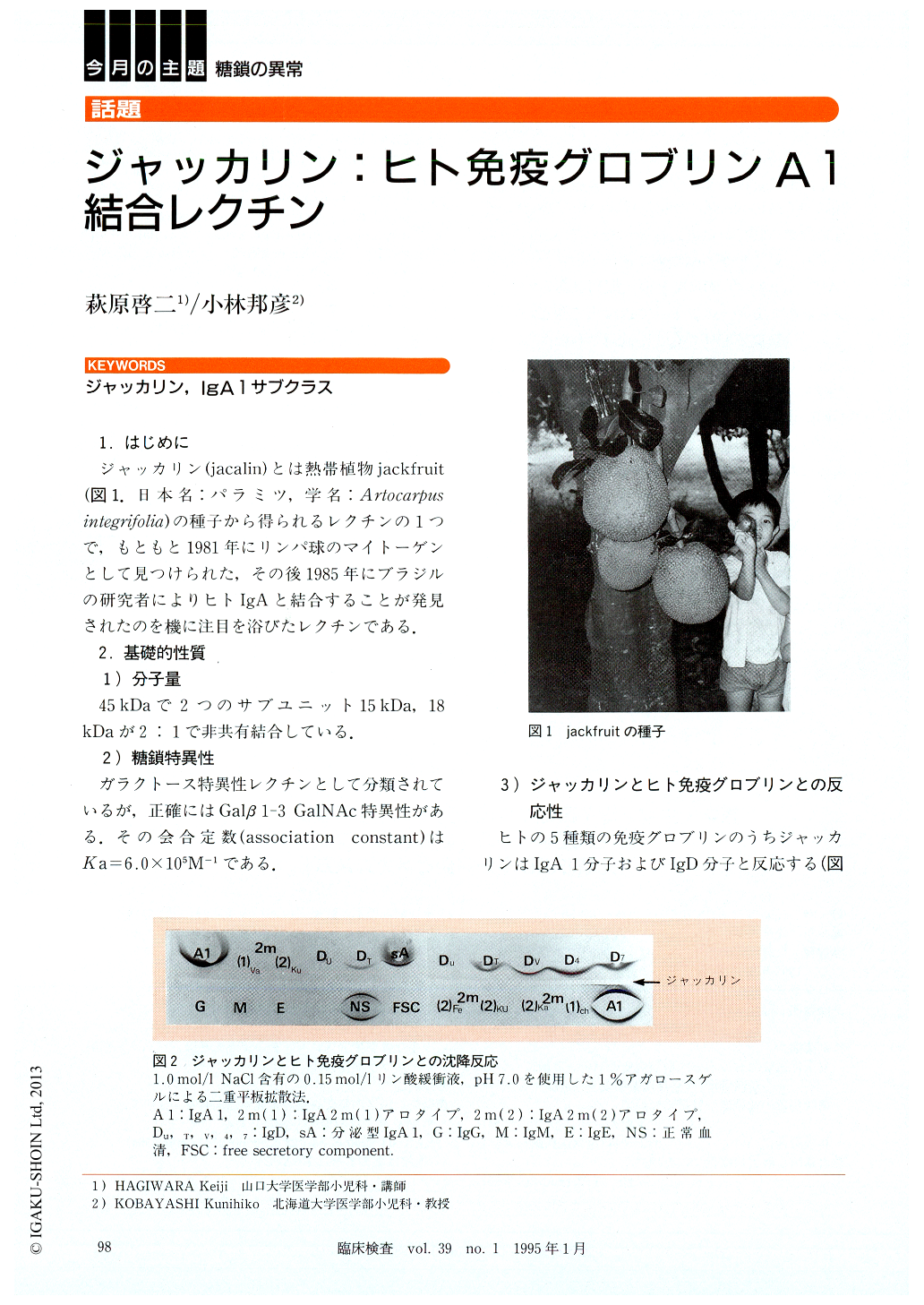- 著者
- 山本 勝 武井 達哉 萩原 啓 堺 俊克 村上 由紀夫 後沢 瑞芳 山本 敏裕 村上 裕彦 三浦 治 平川 正明 中野 美尚 岡坂 謙介 浅見 佳司 金子 喜代三 佐々木 貴英
- 出版者
- 一般社団法人電子情報通信学会
- 雑誌
- 電子情報通信学会技術研究報告. EID, 電子ディスプレイ (ISSN:09135685)
- 巻号頁・発行日
- vol.103, no.594, pp.41-44, 2004-01-17
- 被引用文献数
- 3
陰極材料に炭素系材料であるグラファイトナノファイバー(GNF)を用いた電界放射ディスプレイ(FED)を検討している。今回、ガラスフリットを用いた窒素雰囲気中での封着プロセスによりパネル化し、動画像を表示して良好に動作することを確認した。また電子放出特性の測定も行い、次世代に向けた大画面・高精細・薄型ディスプレイとしての実現性を示した。
1 0 0 0 ジャッカリン:ヒト免疫グロブリンA1結合レクチン
- 著者
- 萩原 啓二 小林 邦彦
- 出版者
- 医学書院
- 雑誌
- 臨床検査 (ISSN:04851420)
- 巻号頁・発行日
- vol.39, no.1, pp.98-100, 1995-01-15
1.はじめに ジャッカリン(jacalin)とは熱帯植物jackfruit(図1.日本名:パラミツ,学名:Artocarpusintegrifolia)の種子から得られるレクチンの1つで,もともと1981年にリンパ球のマイトーゲンとして見つけられた,その後1985年にブラジルの研究者によりヒトIgAと結合することが発見されたのを機に注目を浴びたレクチンである.
1 0 0 0 OA 赤外線モーションセンサを用いた睡眠時体動の評価
- 著者
- 城 和男 萩原 啓
- 出版者
- 公益社団法人 日本生体医工学会
- 雑誌
- 生体医工学 (ISSN:1347443X)
- 巻号頁・発行日
- vol.47, no.1, pp.7-14, 2009-02-10 (Released:2009-08-13)
- 参考文献数
- 16
- 被引用文献数
- 1
The present study was conducted in order to clarify the features of the occurrences of body movement during nighttime sleep and estimate the depth of sleep. Sleep experiments were conducted on seven healthy, non-medicated subjects, aged20-23years (5 males and 2 females) for 7 hours. During sleep, body movement was measured by electroencephalography (electroencephalography body movement: EEGBM) and by a passive infrared type motion sensor (NapVIEW body movement: NapVIEWBM) . Among all subjects, the mean concordance rate between EEGBM and NapVIEWBM was 0.95 ± 0.03. This finding suggests that it is possible to measure body movement with a 90% or greater concordance with EEGBM using a non-contact method, such as NapVIEW. Analysis of the relationship between body movement intervals and depth of sleep showed that the interval between body movements was longer during deep sleep and shorter during light sleep. Sleep state was evaluated based on data obtained by detailed analysis of the interval between body movements. Linear discriminant analysis was conducted on the interval data obtained by NapVIEWBM to divide into a group of light sleep stages and a group of deep sleep stages. A concordance rate of 90.5% between estimated depth of sleep and actual sleep stage was obtained during light sleep, while a concordance rate of 70.8% was obtained during deep sleep. These findings indicate that sleep state can be adequately evaluated based on depth of sleep as indicated by body movement.
1 0 0 0 OA 体動の出現頻度を用いた睡眠周期推定の試み
- 著者
- 神林 優太 萩原 啓
- 出版者
- 公益社団法人 日本生体医工学会
- 雑誌
- 生体医工学 (ISSN:1347443X)
- 巻号頁・発行日
- vol.50, no.1, pp.99-104, 2012-02-10 (Released:2012-07-13)
- 参考文献数
- 24
Accurate assessment of the sleep cycle at home will improve self-awareness regarding the necessity of sleep for relieving fatigue. Previous studies have shown that a large number of body movements occur during light sleep compared to deep sleep. In the present study, sleep was assessed by monitoring body movements using an infrared motion sensor and Polysomnography (PSG) for a 420-min period from 00:00 to 07:00. The findings of sleep cycle based on body movements were compared with PSG findings. One cycle of sleep cycle was defined as a set of “REM, sleep level 1, 2, 3 or 4” period and subsequent “SWS, sleep level 5 or 6” period. We defined Body Movement Density (BMD) as an index of sleep cycle. BMD was a value representing the number of body movement occurrences during a 30-minutes period. The cross-correlation coefficient between BMD and sleep levels was significant in all subjects (13 males, 3 females;age, 20-23 years). In this study, a concordance rate of 76.9% (SD±24.0) between BMD cycle and sleep cycle was obtained. This study indicates the possibility of estimation for sleep cycle by using BMD without using PSG. One of the greatest advantages of BMD is that it comprises only body movement data, so measurements of breath, heart rate or brain waves are not required. Moreover, measuring BDM is both inexpensive and noninvasive.
- 著者
- 鈴木 仁治 大橋 一正 関 五郎 西川 豊宏 磯部 絵美 萩原 啓太
- 出版者
- 一般社団法人日本建築学会
- 雑誌
- 学術講演梗概集. D-1, 環境工学I, 室内音響・音環境, 騒音・固体音, 環境振動, 光・色, 給排水・水環境, 都市設備・環境管理, 環境心理生理, 環境設計, 電磁環境 (ISSN:13414496)
- 巻号頁・発行日
- vol.2007, pp.569-570, 2007-07-31
- 被引用文献数
- 1
